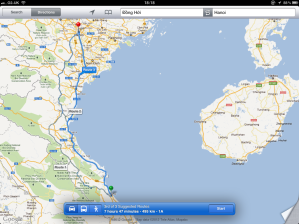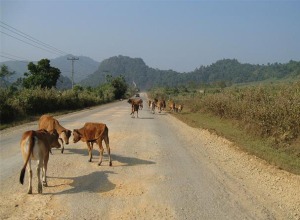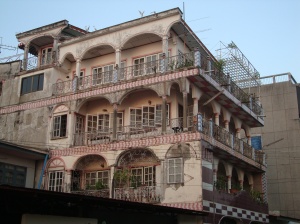Big journey today. The plotted route on Google maps gives me three possible routes and I choose Route 3 for no other reason than it follows the coast all the way up. There’s less than half an hour between the routes, and I fancy having the wind in my hair. If I had any hair, that is.
So I have the earliest breakfast the hotel can give me and I head off to give the camper a check over. Dong Hoi is actually quite nice. Dong Hoi is the capital of the Quang Binh region, and the estuary adds a seaside feel to the whole place and fishing is clearly one of its main industries.
In 1926, a French female archaeologist, Madeleine Colani discovered many items in caves in west Quang Binh. With Carbon14 tests, the artefacts were dated back to 10,509 years ago.
Now, I have to say I have a bit of an interest in things dating back to 10,000 BC, or there a bouts. This seems to come up an awful lot in ancient history and is largely seen as the starting point of the warming of the Earth and the end of the Glacial period. In popular culture, Atlantis was destroyed about 9,600 BC. Some people even suggest that an Alien race set up shop around this time in various parts of the world, but that’s for another day.
I head north and find my virtual self on the AH01 again, which is actually quite comforting. Vietnam drive on the right, which is fine, but I do have to pay attention on junctions. In fact, almost all of the countries that drive on the left are old British Colonial states. Practically every other one drives on the right. (You can always check using whatsideoftheroad.com. It seems to be accurate, but second check if it’s important.) For safety sake, if you are a British citizen, like me, register with the Foreign Office’s LOCATE system. Many other western nations have similar systems that allow a quick response if you get into trouble as a traveller. While I am on the subject, the British Foreign Office tell me that there are no current travel restrictions in Vietnam for me.
It takes me almost three hours to get to Vinh, another estuary city on the coast. I cross the Vinh bridge and into the city. In the 1950′s, much of the original city was destroyed in the countless battles between the French and the Viet Minh, which means the city I pass through is mostly modern. As I leave Vinh to the north, I drive into Cua Lo, one of the most popular resorts in this part of Vietnam.
One thing I notice about the last few countries I have been through, and that’s how many bridges I get to cross. I barely get a few hours before I have to cross another one. Having the sea on my right is not helping, and I cross another 14 before I arrive at Hanoi. I ‘book’ a room in the Rising Dragon Palace Hotel for £35, just a mile form the railway station and views of Hanoi’s Old Quarter. My camper goes into the parking bay and I take an overnight bag. I plan on staying in Hanoi to take the time to look around, get a feel for the city and find some great history.

































